Geodia gibberosa Lamarck, 1815
| Native range | All suitable habitat | Point map | Year 2050 |

|
| This map was computer-generated and has not yet been reviewed. |
| Geodia gibberosa AquaMaps Data sources: GBIF OBIS |
Upload your photos
Google image |
No photo available for this species.No drawings available for Geodiidae.
Google image |
No photo available for this species.
Classification / Names Common names | Synonyms | CoL | ITIS | WoRMS
Demospongiae | Tetractinellida | Geodiidae
Environment: milieu / climate zone / depth range / distribution range Ecology
Reef-associated; brackish; depth range 1 - 90 m (Ref. 108813). Tropical
Distribution Countries | FAO areas | Ecosystems | Occurrences | Introductions
Western Atlantic: USA and Caribbean.
Length at first maturity / Size / Weight / Age
Maturity: Lm ? range ? - ? cm
Short description Morphology
Massive; irregular, globular, or lobate of at least 30 cm across. Firm and slighthly compressible. Smooth and non-porous, with ostia present. Sediments, algae and other encrusting sponges usually cover surfaces without ostia. External color: Whitish in dark habitats, dark brown when exposed to light. Cream internal.
Occurs in shallow inshore hard bottoms (Ref. 85482) and mangrove ponds (Ref. 86789). In Belize, it is found in a submarine cave near Columbus Cay (Ref. 87209).
Life cycle and mating behavior Maturity | Reproduction | Spawning | Eggs | Fecundity | Larvae
Members of the class Demospongiae are hermaphroditic. Life cycle: The zygote develops into parenchymella larva (free-swimming) before settling down on a substrate where it grows into a young sponge.
Main reference
References | Coordinator | Collaborators
Engel, S. and J.R. Pawlik. 2005. (Ref. 836)
IUCN Red List Status (Ref. 130435)
CITES status (Ref. 108899)
Not Evaluated
CMS (Ref. 116361)
Not Evaluated
Threat to humans
Human uses
| FishSource |
Tools
More information
Internet sources
BHL | BOLD Systems | CISTI | DiscoverLife | FAO(Publication : search) | Fishipedia | GenBank (genome, nucleotide) | GloBI | Gomexsi | Google Books | Google Scholar | Google | PubMed | Tree of Life | Wikipedia (Go, Search) | Zoological Record
Estimates based on models
Preferred temperature
(Ref. 115969): 22.7 - 28, mean 26.1 (based on 354 cells).
Price category
(Ref. 80766):
Unknown.


